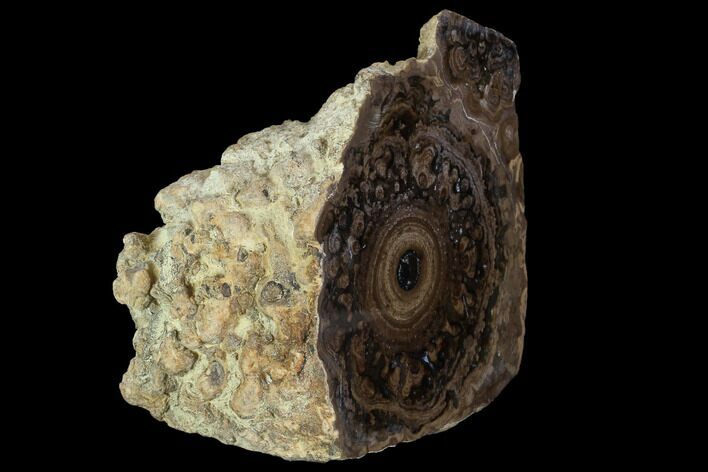This Specimen has been sold.
Polished, 4.4" Fossil Stromatolite Colony on Reed - Utah
This is a fascinating 4.4" wide fossil end-cut that features stromatolite colonies that formed around an unidentified plant. This specimen came from a collection that was gathered in the 1980s and 1990s, however, much of the information regarding the specific locality of extraction has been lost over the years. What is known about this specimen is that it was found at Old Lake Uintah of Carbon County, Utah.
Based on information provided by stromatolite experts, the colonies are believed to be oncolytic stromatolites. Oncolytic stromatolites are spherical in formation, typically forming around a solid "nucleus" like a rock, grain of sand, or in this instance, a plant. It's speculated that the concentric-ringed plant that acted as the nucleus for this stromatolite formation was likely a reed or fern.
This specimen has been cut and polished to a mirror-like finish on one side. It comes with an acrylic display stand. There is a repaired crack through this slab.
Based on information provided by stromatolite experts, the colonies are believed to be oncolytic stromatolites. Oncolytic stromatolites are spherical in formation, typically forming around a solid "nucleus" like a rock, grain of sand, or in this instance, a plant. It's speculated that the concentric-ringed plant that acted as the nucleus for this stromatolite formation was likely a reed or fern.
This specimen has been cut and polished to a mirror-like finish on one side. It comes with an acrylic display stand. There is a repaired crack through this slab.
About Stromatolites
Stromatolites are fascinating, ancient rock formations created by the activity of cyanobacteria and other microorganisms. These layered, mound-like structures represent some of the earliest evidence of life on Earth, dating back over 3.5 billion years. Often found in shallow, warm waters, stromatolites form as layers of sediment and minerals are trapped and bound by microbial mats, gradually building up over time into unique, textured shapes.
Visually, stromatolites can range from smooth, rounded forms to intricate, banded structures, with colors that span earthy reds, browns, greens, and grays. Each layer captures a record of environmental conditions at the time of its formation, making stromatolites an invaluable source of information for scientists studying Earth’s early history and the origins of life.
Today, fossilized stromatolites are highly prized by collectors, both for their scientific significance and their natural beauty. Some living stromatolites can still be found in a few rare locations around the world, such as Shark Bay in Australia and certain alkaline lakes.
Stromatolites are fascinating, ancient rock formations created by the activity of cyanobacteria and other microorganisms. These layered, mound-like structures represent some of the earliest evidence of life on Earth, dating back over 3.5 billion years. Often found in shallow, warm waters, stromatolites form as layers of sediment and minerals are trapped and bound by microbial mats, gradually building up over time into unique, textured shapes.
Visually, stromatolites can range from smooth, rounded forms to intricate, banded structures, with colors that span earthy reds, browns, greens, and grays. Each layer captures a record of environmental conditions at the time of its formation, making stromatolites an invaluable source of information for scientists studying Earth’s early history and the origins of life.
Today, fossilized stromatolites are highly prized by collectors, both for their scientific significance and their natural beauty. Some living stromatolites can still be found in a few rare locations around the world, such as Shark Bay in Australia and certain alkaline lakes.
SPECIES
Unidentified Reed
LOCATION
Old Lake Uintah, Carbon County, Utah
FORMATION
Unknown
SIZE
4.4 x 4.3"
CATEGORY
ITEM
#100366
We guarantee the authenticity of all of our specimens.
 Reviews
Reviews












